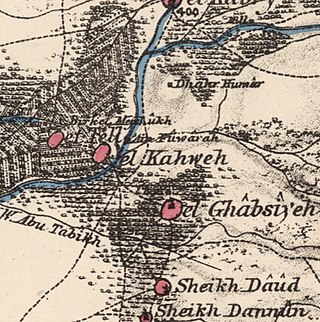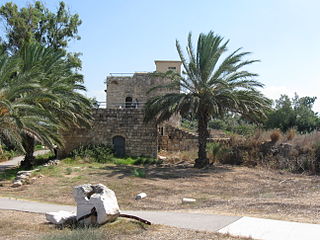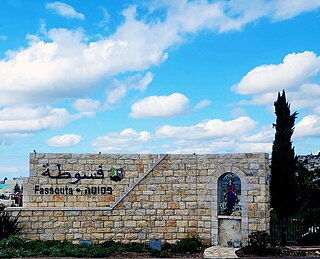
Achziv or Az-Zeeb is an ancient site on the Mediterranean coast of northern Israel, between the border with Lebanon and the city of Acre. It is located 13.5 kilometres (8.4 mi) north of Acre on the coast of the Mediterranean Sea, within the municipal area of Nahariya. Today it is an Israeli national park.

Nahf is an Arab town in the Northern District of Israel. It is located in between the lower and upper Galilee, about 23 kilometres (14 mi) east of Acre. In 2022 it had a population of 13,717. Archaeologists believe that the area was an important center for viticulture in the Hellenistic period and possibly the Early Bronze Age IB period.

Al-Ruways, was a Palestinian Arab village on a rocky hill located 12 kilometers (7.5 mi) southeast of Acre and south of the village of al-Damun. Its population in 1945 was 330. Al-Ruways was depopulated following its capture by Israeli forces during the 1948 Arab-Israeli War.

Suhmata, was a Palestinian village, located 25 kilometres (16 mi) northeast of Acre. It was depopulated by the Golani Brigade during the 1948 Arab-Israeli war.

Dayr al-Qassi or Deir el-Qasi, was a Palestinian Arab village located 26 km northeast of the city of Acre, which was depopulated during 1948 Arab-Israeli war.

Al-Ghabisiyya was a Palestinian Arab village in northern Palestine, 16 km north-east of Acre in present-day Israel. It was depopulated by the Israel Defense Forces during the 1948-1950 period and remains deserted.

Kuwaykat, also spelled Kuweikat, Kweikat or Kuwaikat, was a Palestinian village located 9 km northeast of Acre. It was depopulated in 1948.

Umm al-Faraj, was a Palestinian village, depopulated in 1948.

Sa'sa' was a Palestinian village, located 12 kilometres northwest of Safed, that was depopulated by Israeli forces during the 1948 Arab-Israeli war. The village suffered two massacres committed by Haganah forces: one in mid-February 1948 and the other at the end of October the same year. Its place has been taken since 1949 by Sasa, an Israeli kibbutz.

Tel Afek,, also spelled Aphek and Afeq, is an archaeological site located in the coastal hinterland of the Ein Afek Nature Reserve, east of Kiryat Bialik, Israel. It is also known as Tel Kurdani.

Fassouta is a Christian Arab village in the Galilee. It is located on the northwestern slopes of Mount Meron, south of the Lebanese border. In 2022 it had a population of 3,255, nearly all of whom are Melkite Christian Arabs.

Mazra'a is an Arab town and local council in northern Israel, situated between Acre and Nahariyya east of the Coastal Highway that runs along the Mediterranean coast. The local council was founded in 1896 and was incorporated into the Matte Asher Regional Council in 1982, before proclaiming itself an independent local council again in 1996. In 2022 it had a population of 4,115.

Kafr Yasif is an Arab town in the Northern District of Israel. It is located 11 kilometers (6.8 mi) northeast of the city of Acre and adjacent to Abu Sinan and Yarka. The population of Kafr Yasif is half Christian (52.1%) with the rest Muslim (44.9%), and a small Druze community.

Nein — also Nain or Naim in English — is an Arab village in northern Israel. Located in the Lower Galilee, 14 kilometers (8.7 mi) south of Nazareth, Nein covers a land area of approximately 1,000 dunams and falls under the jurisdiction of Bustan al-Marj Regional Council, whose headquarters it hosts. Its total land area consisted of 3,737 dunums prior to 1962. According to the Israeli Central Bureau of Statistics, in 2022 it had a population of 1,994.

Yanuh-Jat is an Israeli Druze village and local council in the Northern District of Israel, northeast of Acre, consisting of the villages of Yanuh and Jat, which merged in 1990. In 2022 it had a population of 6,930, all members of the Druze community.

Ga'aton is a kibbutz in northern Israel. Located in the western Galilee, it falls under the jurisdiction of Mateh Asher Regional Council. In 2022 it had a population of 725.

Mi'ilya is an Arab local council in the western Galilee in the Northern District of Israel. Its name during the Kingdom of Jerusalem era in Galilee was Castellum Regis. In 2022 it had a population of 3,281, all of whom are Melkite Greek Catholics. The town is located immediately to the northwest of Ma'alot-Tarshiha.

Al-Qabu was a Palestinian Arab village in the Jerusalem Subdistrict. The name is an Arabic variation of the site's original Roman name, and the ruins of a church there are thought to date to the era of Byzantine or Crusader rule over Palestine.

Yaquq was a Palestinian Arab village, which was depopulated during the 1947–1948 Civil War in Mandatory Palestine on May 1, 1948. It was located 12.5 km north of Tiberias and was built at the site of the ancient Jewish village of Huqoq.

Fardisya was a Palestinian Arab hamlet in the Tulkarm Subdistrict, 2.5 kilometres (1.6 mi) south of Tulkarm.



























